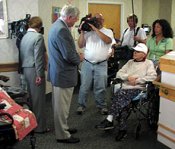|
The Issue
In February 2003, an
early morning fire at the Greenwood Health Center,
a nursing home in Hartford,
CT, claimed the lives of sixteen
residents. A similar fire in Nashville,
TN later that year killed fifteen
residents. In both cases, these facilities lacked an automatic fire sprinkler
system.
Over 1.6 million elderly and disabled Americans live in nursing homes across
the country. With limited mobility and health related impairments, this
population is particularly at risk during a fire. The only way to virtually
eliminate the threat of fire for these Americans is to install a fully
operational automatic fire sprinkler system.
Of the over 16,000 nursing homes nationwide, the Government Accountability
Office (GAO) estimates that approximately 20 to 30 percent lack an automatic
fire sprinkler system.
While there is no record of a multi-death fire in a nursing home with an
automatic fire sprinkler system, the federal government has no comprehensive
standard which requires all nursing homes to have sprinkler systems, regardless
of age.
On July 16, 2004, the Government Accountability Office (GAO) released a report
which concluded that “the substantial loss of life in the Hartford
and Nashville
fires could have been reduced or eliminated by the presence of properly
functioning automatic sprinkler systems.” Alarmingly, the report also found
that “state and federal oversight of nursing home compliance with fire safety
standards is inadequate.”
According to the GAO and
industry experts, the single biggest obstacle preventing most nursing homes
from installing sprinklers is the cost. Already burdened by the increasing cost
to care for their residents and shortfalls in the Medicare funding they rely
on, they simply cannot afford these systems. In addition, while CMS has it
within their authority to increase fire safety standards and mandate the
installation of sprinklers, it has repeatedly shied away from doing so because
of the cost that would be passed on to nursing homes.
The Solution
 On December 8, 2005, I
joined Representative Peter King (R-NY) in introducing the Nursing Home Fire
Safety Act. The bill addresses the primary obstacle – the cost - to
installing sprinklers by directing the Secretary of Health and Human Services
to establish both a loan program and need-based grant program to aid nursing
homes in tackling the high cost of installing sprinklers. On December 8, 2005, I
joined Representative Peter King (R-NY) in introducing the Nursing Home Fire
Safety Act. The bill addresses the primary obstacle – the cost - to
installing sprinklers by directing the Secretary of Health and Human Services
to establish both a loan program and need-based grant program to aid nursing
homes in tackling the high cost of installing sprinklers.
The loan program would
assist nursing homes that cannot afford the up-front cost of retrofitting their
facilities, but could afford to pay back a low interest government backed
loan. The grant program would target those nursing homes in the greatest
need of financial assistance in installing sprinkler systems by requiring the
Secretary of Health and Human Services to give priority to homes that lack the
resources to install these systems on their own.
In addition, the bill
expresses the sense of Congress that every nursing home in
America
should be equipped with full sprinkler systems within five years and that CMS
should move quickly to adopt stronger fire safety standards.
Representative
King and I reintroduced the Nursing
Facility Fire Safety Act (H.R. 2521) for the 110th Congress on May 24,
2007. I also toured Riverside Health and Rehabilitation
Center in East
Hartford on August 8, 2007, to discuss the importance of nursing
facility safety issues.

Legislative
Information
Letters of Support
GAO Report on Nursing Home Fire
Safety (GAO-04-660)
|


